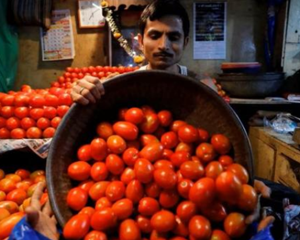India faces a severe tomato shortage due to extreme weather-induced crop failures, causing a staggering 400 percent price surge.
由于极端天气导致的作物歉收,印度正面临严重的西红柿短缺,进而导致西红柿的价格飙升了400%。
The tomato, central to many Indian dishes today, has existed for only about 400 of its thousands of years of civilization.
西红柿是今天许多印度菜的核心,在印度数千年的文明史中,西红柿只存在了大约400年。
Introduced from the Americas by Portuguese explorers in the 16th century,
西红柿是在16世纪时由葡萄牙探险家从美洲引进的,
the tomato's incorporation into Indian cuisine occurred only after two centuries.
而其被纳入印度菜肴,则是发生在两个世纪之后。

Before the tomato's arrival, tamarind, a native fruit,
在西红柿被引入之前,罗望子,一种印度本地水果,
was a primary souring agent in dishes ranging from fish curries to a mixed vegetable dish known as "Avial".
是从咖喱鱼到一种被称为“Avial”的混合蔬菜的各种菜肴中的主要酸味剂。
The current tomato shortage has led households to revisit traditional ingredients, such as tamarind, or used canned alternatives.
目前西红柿短缺这一状况,使得印度家庭重新拾起了诸如罗望子在内的传统原料,亦或是使用那些用过的罐装替代品。
The tomato crisis has touched various aspects of Indian life, from chains like McDonald's to low-income households and tomato farmers.
西红柿危机影响了印度人生活的方方面面,从麦当劳这样的连锁店,到低收入家庭、种植西红柿的农民皆是如此。
The shortage underscores the implications of climate change.
而这种短缺也凸显了气候变化的影响。












